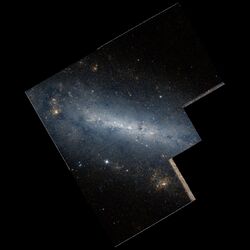Astronomy:NGC 672
| NGC 672 | |
|---|---|
 NGC 672, imaged by the Hubble Space Telescope | |
| Observation data (J2000 epoch) | |
| Constellation | Triangulum |
| Right ascension | 01h 47m 54.47627s[1] |
| Declination | +27° 25′ 57.9948″[1] |
| Redshift | 0.001403[2] |
| Helio radial velocity | 425[3] km/s |
| Distance | 23.42 ± 0.33 Mly (7.18 ± 0.10 Mpc)[4] |
| Apparent magnitude (V) | 11.09±0.03[5] |
| Characteristics | |
| Type | SB(s)cd[6] |
| Mass | 3.8×1010 M☉[7] M☉ |
| Apparent size (V) | 6′.17 × 2′.29[8] |
| Other designations | |
| MCG+04-05-011, VV 338, 2MASX J01475452+2725580, IRAS 01450+2710, NGC 672, UGC 1256, PGC 6595[9] | |
NGC 672 is a spiral galaxy in the northern constellation of Triangulum, positioned around 2° to the southwest of the star Alpha Trianguli.[10] The original object designated NGC 672 was discovered by the German-born astronomer William Herschel on 26 October 1786, but this was later cataloged as NGC 614. The object now identified as NGC 672 was discovered by John Herschel on 11 November 1827.[11]
This galaxy is located at a distance of approximately 23.4 megalight-years from the Milky Way,[4] where it forms an interacting pair with the irregular galaxy IC 1727.[12][13] In the neutral hydrogen radio band, a tidal bridge is observed between the galaxies.[14] NGC 672 appears to be the more massive of the two, and hence IC 1727 shows more distortion from the interaction.[7] Together they form members of a combined group of galaxies that includes NGC 784.[15]
The morphological classification of NGC 672 is SB(s)cd,[6] which indicates this is a barred spiral galaxy (SB), with no ring structure around the central bar (s), and moderately to loosely-wound spiral arms. In the visual spectrum, the galaxy appears symmetrical with clearly defined spiral arms.[14] It is gas-rich with an estimated mass of 38 billion times the mass of the Sun and a star formation rate of 0.3 M☉ yr−1.[7]
References
- ↑ Jump up to: 1.0 1.1 Brown, A. G. A. (August 2018). "Gaia Data Release 2: Summary of the contents and survey properties". Astronomy & Astrophysics 616: A1. doi:10.1051/0004-6361/201833051. Bibcode: 2018A&A...616A...1G. Gaia DR2 record for this source at VizieR.
- ↑ Kochanek, C. S. et al. (October 2001). "The K-Band Galaxy Luminosity Function". The Astrophysical Journal 560 (2): 566–579. doi:10.1086/322488. Bibcode: 2001ApJ...560..566K.
- ↑ Tully, R. Brent et al. (2016). "Cosmicflows-3". The Astronomical Journal 152 (2): 50. doi:10.3847/0004-6256/152/2/50. Bibcode: 2016AJ....152...50T.
- ↑ Jump up to: 4.0 4.1 Tully, R. Brent et al. (October 2013). "Cosmicflows-2: The Data". The Astronomical Journal 146 (4): 25. doi:10.1088/0004-6256/146/4/86. 86. Bibcode: 2013AJ....146...86T.
- ↑ Cook, David O. et al. (2014). "The Spitzer Local Volume Legacy (LVL) global optical photometry". Monthly Notices of the Royal Astronomical Society 445 (1): 881. doi:10.1093/mnras/stu1580. Bibcode: 2014MNRAS.445..881C.
- ↑ Jump up to: 6.0 6.1 Konstantopoulos, I. S. et al. (May 2013). "The Snapshot Hubble U-band Cluster Survey (SHUCS). I. Survey Description and First Application to the Mixed Star Cluster Population of NGC 4041". The Astronomical Journal 145 (5): 20. doi:10.1088/0004-6256/145/5/137. 137. Bibcode: 2013AJ....145..137K.
- ↑ Jump up to: 7.0 7.1 7.2 Ramirez-Ballinas, I.; Hidalgo-Gámez, A. M. (August 2014). "Diffuse ionized gas and chemical abundances in IC 1727". Monthly Notices of the Royal Astronomical Society 442 (3): 2282–2295. doi:10.1093/mnras/stu722. Bibcode: 2014MNRAS.442.2282R.
- ↑ Paturel, G. et al. (December 2003). "HYPERLEDA. I. Identification and designation of galaxies". Astronomy and Astrophysics 412: 45–55. doi:10.1051/0004-6361:20031411. Bibcode: 2003A&A...412...45P.
- ↑ "NGC 672". SIMBAD. Centre de données astronomiques de Strasbourg. http://simbad.u-strasbg.fr/simbad/sim-basic?Ident=NGC+672.
- ↑ Sinnott, Roger W.; Perryman, Michael A. C. (1997). Millennium Star Atlas. 1. Sky Publishing Corporation and the European Space Agency. p. 164. ISBN 0-933346-84-0.
- ↑ Seligman, Courtney. "NGC Objects: NGC 600 - 649". https://cseligman.com/text/atlas/ngc6.htm#627.
- ↑ Tikhonov, N. A. et al. (January 2014). "Stellar content of the interacting galaxies IC 1727 and NGC 672". Astronomy Letters 40 (1): 11–21. doi:10.1134/S106377371401006X. Bibcode: 2014AstL...40...11T.
- ↑ Combes, F. et al. (April 1980). "Neutral hydrogen observations and computer modelling of the interacting galaxies NGC 672-IC 1727". Astronomy and Astrophysics 84: 85–92. Bibcode: 1980A&A....84...85C.
- ↑ Jump up to: 14.0 14.1 Stanchfield, Sara; Wilcots, E.; Prescott, M. (May 2012). "An HI and Optical Study of Interacting Galaxies NGC 672 and IC 1727". American Astronomical Society, AAS Meeting #220. 524.19. Bibcode: 2012AAS...22052419S.
- ↑ McQuinn, Kristen B. W. et al. (April 2014). "Distance Determinations to SHIELD Galaxies from Hubble Space Telescope Imaging". The Astrophysical Journal 785 (1): 3. doi:10.1088/0004-637X/785/1/3. 3. Bibcode: 2014ApJ...785....3M.
External links
 |

